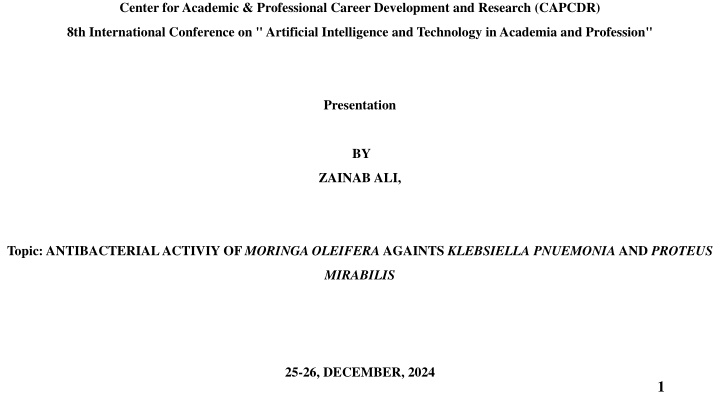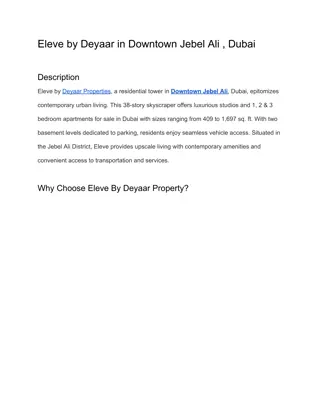
Evaluating Antibacterial Activity of Moringa against Klebsiella and Proteus
Explore the antimicrobial potential of Moringa oleifera against Klebsiella pneumoniae and Proteus mirabilis. The study aims to address the paucity of evidence on Moringa's effectiveness against these bacteria, crucial for combating antibiotic resistance and improving patient outcomes.
Download Presentation

Please find below an Image/Link to download the presentation.
The content on the website is provided AS IS for your information and personal use only. It may not be sold, licensed, or shared on other websites without obtaining consent from the author. If you encounter any issues during the download, it is possible that the publisher has removed the file from their server.
You are allowed to download the files provided on this website for personal or commercial use, subject to the condition that they are used lawfully. All files are the property of their respective owners.
The content on the website is provided AS IS for your information and personal use only. It may not be sold, licensed, or shared on other websites without obtaining consent from the author.
E N D
Presentation Transcript
Center for Academic & Professional Career Development and Research (CAPCDR) 8th International Conference on "Artificial Intelligence and Technology in Academia and Profession" Presentation BY ZAINAB ALI, Topic: ANTIBACTERIAL ACTIVIY OF MORINGA OLEIFERA AGAINTS KLEBSIELLAPNUEMONIA AND PROTEUS MIRABILIS 25-26, DECEMBER, 2024 1
Introduction Moringa oleifera is a plant that is widely used for its medicinal properties and has been found to have antimicrobial activity. Study have shown that extracts from the leaves, seeds, and bark of the plant have inhibitory effects against a range of bacteria, including klebsiella, Staphylococcus aureus, Escherichia coli, and Pseudomonas aeruginosa ,proteus , as well as fungi such as Candida albicans (Zhang et al., 2018). The antimicrobial properties of Moringa have been attributed to the presence of compounds such as flavonoids, phenolic acids, and terpenoids. Which have been shown to have antibacterial and antifungal effects. Additionally, studies have also shown that Moringa extract can enhance the activity of antibiotics, suggesting that it may have potential as an adjuvant therapy in the treatment of infections (Elgamily et al., 2016). 2
Statement of Research Problem Despite the potential of Moringa as a source of antimicrobial agents, there is a paucity of scientific evidence to support its effectiveness against Klebsiella and Proteus (Lin et al., 2019). The antimicrobial activity of Moringa has been reported against several other microorganisms, but its effectiveness against Klebsiella and Proteus is limited. Therefore, the research problem is to evaluate the antimicrobial activity of Moringa against Klebsiella andProteus bacteria. 3
Justification of Research The study of antibacterial activity against Klebsiella and Proteus is important because these are Gram-negative bacteria that can cause various infections in humans. such as pneumonia, urinary tract infections, and sepsis. Klebsiella and Proteus are also known to be resistant to multiple antibiotics, making it necessary to find new and effective treatments. Studying the antibacterial activity of various substances can help in the development of new and more effective antibiotics, which can help reduce the spread of antibiotic-resistant strains of Klebsiella and Proteus and improve patient outcomes. 4
Aims and Objectives The aim of this study is to evaluate the antibacterial activity of a particular substance (moringa) against Klebsiella pneumoniae and Proteus mirabilis. Specific objectives of this study are to: To identify the test isolates from clinical sample obtain from FMC To evaluate the phytochemical properties of moringa oleifera To determine the antibacterial activity of moriga oleifera against Klebsiella and Proteus. 5
Materials and Methods Study Area Aleiro is a Local Government area situated in Kebbi State, North-Western Nigeria. Has a latitude 12o 16 42 N and longitude 4o 27 6 1 E. The estimated population of the L.G.A is 232,846 people in (NPC, 2006). The local government is bounded by Sokoto State to the north and east, Niger state to the south. It has area land mass of 51 km2 the occupation of most of the people in Aliero LGA area. With emphasis on vegetation, especially onion and pepper. The town has the largest onion market in northwest Nigeria and is a major producer of onions in Nigeria. Aliero residents are known for bone setting across West and Central Africa. Aliero town is surrounded by mango trees. The name Aliero was originally from two prominent Fulani scholars Ali & Yero. The town is the headquarters of Aliero Local Government Area. 6
Materials and Methods Sample Collection The plant seeds and bark of Moringa oleifera was collected from matured healthy trees in a homestead garden at Aliero Local Government Area, Kebbi State, Nigeria and were taken to microbiology laboratory of Kebbi State University Of Science And Technology, Aliero. The specimens were re-identified by a Taxonomist, in the Department of Plant Science and Biotechnology, Falculty of Life Sciences, KebbiState University of Science and Technology, Aliero. 7
Materials and Methods Preparation of the Extract The procedure described by (Isah et al., 2020) was adopted for the preparation of aqueous and methanolic extracts of M. oleiferaseed and bark. The fresh bark and seed was air dried at room temperature for seven days after which it was pulverized to powder using mortar and pestle and stored in a plastic sterilized container. Fifty gram (50g) of the air-dried powdered seed and bark was sockedin 250ml concentrated methanol and sealed with foil paper tightly and kept undisturbed for 24 h. The solutions were filtered and concentrated in a water bath at 100 C and 65 C methanolic extracts. 8
Results Test Organisms Indole Urease Citrate Catalase MR VP Klebsiella Pneumonia _ + + + _ + Proteus Mirabilis _ + + + + _ 9
Results Table 4.1: Phytochemical analysis of bark and seed of M. oleifera Phytochemicals Status Saponin + Tannins - Steroids + Alkaloids + Flavonoids + 10 Glycoside +
Results Concentration (g/ml) Zone of inhibition (mm) P. mirabilis K. pneumoniae 0.3g/ml 26 6 0.2g/ml 20 5 0.1g/ml 15 10 Ciprofloxacin (500mg) (Positive control) 22 21 Water (Negative control) 0 0 11
Discussion Revealed the results of phytochemical screening of the methanolic bark and seed extracts of M. oleifera which depicted the presence of alkaloids, flavonoids, saponins, steroides, glycosides and absence of, tannins, in methanolic seed and bark extract when analyzed qualitatively.The rapid discovery of various medicinal plants with different classes of natural products(secondary metabolites) has provided a remarkable intervention in history. The presence of secondary metabolites in medicinal plants has been linked with antimicrobial properties of crude plant extracts (Compean and Ynalvez, 2014). The screening of phytochemicals in M. oleifera revealed the presence of alkaloids, flavonoids, tannins, saponins, glucosides (Table 1) and these phytochemicals have the ability to inactivate microbial adhesions, thus inhibiting the growth of various bacterial strains. However, results of the present study indicated lack of alkaloids in the bark and seed extract of M. oleifera which is in line with the literature review (Fahalet al. 2018). Literature review reported the presence of tannins (Abdrani et al., 2018).while the investigated species growing in Aliero kebbi state lacked tannins in the seed and bark extracts. The difference may be due to the geographical location and environmental conditions of the investigated plant species. 12
Discussion Revealed the Antibacterial susceptibility test results of M. oleifera barkand seedextracts against P .mirabilis and K. pneumoniae using zone of inhibition (ZOI). Out of 30 P. mirabilis(13)and K. pneumoniae(17)isolate collected. 19 was re-confirmed as P .mirabilis(8)and K. pneumonia(11).The ZOI of M. oleifera extracts at concentrations of 0.3 g/mL, 0.2 g/mL, and 0.1 g/mL, and for the positive control, ciprofloxacin (500 mg) was respectively for seedand bark and 26, 20, 15 and 22mm, against P .mirabilis. The ZOI of M. oleiferaseed and bark extracts at concentrations of 0.3 g/mL, 0.2 g/mL, and 0.1 g/mL and for the positive control ciprofloxacin (500 mg), were 29, 22, 18 and 21mm against K. pneumonia. The extracts with concentration of 0.3g/mL showed the highest killing susceptibility. Though not potent as that of positive standards, still the antibiogram of microorganisms exposed to methanolic extracts of M. oleifera showed susceptibility to all the bacterial strains. The present results for ZOI of the methanolic seed and bark extract exhibited against K. Pneumoniae (29 mm) are in agreement with Kamath et al. (2016) and Fouad et al. (2019) who reported the ZOI of M. oleiferaethanolic seed and bark extract to be 21 mm and 28.5 mm, respectively. Moreover, the present results for ZOI of the seed extract exhibited against P .mirabilis (26 mm) are also in agreement with reports of Fouad et al. (2019) who reported ZOI of 25.75 mm and but does not comply with Amabye and Tadesse (2016) who reported ZOI to be 8 mm. Furthermore, Abraham and Okon (2014) reported the ZOI of M. oleiferaseed and bark extract to be 12 mm against K. pneumoniae and 9 mm against P .mirabilisand were sensitive according to the NCCLS standard. The medium of extraction of M. oleifera seemed to have an impact on the potency of the active principles which produced wider zones of inhibition, and another factor may be the synergistic effects between methanol and the active principles of the investigated plant 13
Conclusion and Recommendation The findings in this study support the traditional use of M. oleifera and represent an economic and safe alternative drug for the treatment of bacterial infections caused by Gram negative bacteria. A concentration of 0.3- 0.1 g/mL for both the extracts. Though people worldwide are using raw and processed M. oleifera parts, still clinical trials against bacterial infections and a study on metabolic interchanges in bacterial metabolic pathways should be conducted. Moreover, isolation of the secondary metabolites from seed and bark extracts can be helpful in future research and development of pharmaceutical products in Nigeria,especially in Kebbi State, and in vitro study demonstrated that traditional medicine can be as effective as modern medicine to combat human pathogenic bacteria 14
References Adeolu, M., Alnajar, S., Naushad, S., Gupta, R. S. (2016). Genome-based phylogeny and taxonomy of the enterobacteriales : Proposal for Enterobacterales ord. nov. divided into the families Enterobacteriaceae, Erwiniaceae fam. nov., Pectobacteriaceae fam. nov., Yersiniaceae fam. nov., Hafniaceae fam. nov., Morganellaceae fam. nov., and Budviciaceae fam. Nov. Int. J. Syst. Evol. Microbiol. 66, 5575 5599. doi: 10.1099/ijsem.0.001485 alegbeleye, O. S., &Faniyan, T. O. (2018). Antimicrobial potential of Moringaoleifera seed extracts against multidrug-resistant clinical isolates of Proteus species. Journal of Microbiology, Biotechnology and Food Sciences, 7(6), 525-530. Armbruster, C. E., Smith, S. N., Johnson, A. O., DeOrnellas, V., Eaton, K. A., Yep, A., et al. (2017). The pathogenic potential of Proteus mirabilis is enhanced by other uropathogens during polymicrobial urinary tract infection. Infect. Immun. 85, e00808 e00816. doi: 10.1128/IAI.00808-16 Bachman , M.A ., Pugh, N. D., Ma, G., & Pasco, D. S. (2018). Moringaoleifera Lam. inhibits human neutrophil elastase activity. Journal of Ethnopharmacology, 122(3), 492-496. borgonovo, M., Giacoppo, S., De Nicola, G. R., Iori, R., &Bramanti, P. (2020). Moringin activates Wnt canonical pathway by inhibiting GSK3 in a mouse model of experimental autoimmune encephalomyelitis. Drug Design, Development and Therapy, 7, 1399-1410. Brisse, S., Grimont, F., Grimont, P. A. D. (2006). The genus Klebsiella, in The prokaryotes. Eds. Dworkin, M., Falkow, S., Rosenberg, E., Schleifer, K.-H., Stackebrandt, E. (New York: Springer), 159 196. Chen, C. Y., Chen, Y. H., Lu, P. L., Lin, W. R., Chen, T. C., Lin, C. Y. (2012). Proteus mirabilis urinary tract infection and bacteremia: Risk factors, clinical presentation, and outcomes. J. Microbiol. Immunol. Infect. 45, 228 236. doi: 10.1016/j.jmii.2011.11.007 Coban, B., lk , N., Kaplan, H., Topal, B., Erdogan, H., Baskin, E. (2014). Five-year assessment of causative agents and antibiotic resistances in urinary tract infections. Turk. Pediatri. Ars. 49, 124 129. doi: 10.5152/tpa.2014.1505 Cuevas, O., Cercenado, E., Gimeno, M., Mar n, M., Coronel, P., Bouza, E. (2010). Comparative In vitro activity of cefditoren and other antimicrobials against Enterobacteriaceae causing community-acquired uncomplicated urinary tract infections in women: A Spanish nationwide multicenter study. Diagnostic. Microbiol. Infect. Dis. 67, 251 260. doi: 10.1016/j.diagmicrobio.2010.02.013 Dai, H., Chen, A., Wang, Y., Lu, B., Wang, Y., Chen, J., et al. (2019). Proteus faecis sp. nov., and Proteus cibi sp. nov., two newspecies isolated from food and clinical samples in China. Int. J. Syst. Evol. Microbiol. 69, 852 858. doi: 10.1099/ijsem.0.003248 Drzewiecka, D., Arbatsky, N. P., Kondakova, A. N., Shashkov, A. S., Knirel, Y. A. (2016). Structures and serospecificity of threonine-containing O polysaccharides of two clinical isolates belonging to the genus Proteus and their classification into O11 subserogroups. J. Med. Microbiol. 65, 1260 1266. doi: 10.1099/jmm.0.000360 Endimiani, A., Luzzaro, F., Brigante, G., Perilli, M., Lombardi, G., Amicosante, G., et al. (2005). Proteus mirabilis bloodstream infections: Risk factors and treatment outcome related to the expression of extended-spectrum -lactamases. Antimicrob. Agents. Chemother. 49, 2598 2605. doi: 10.1128/AAC.49.7.2598- 2605.2005 15

















